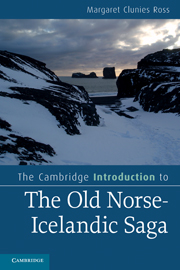Book contents
- Frontmatter
- Contents
- Tables
- A preface on practical issues
- Acknowledgements
- Abbreviations
- Chapter 1 Medieval Iceland
- Chapter 2 What is an Old Norse-Icelandic saga?
- Chapter 3 The genesis of the Icelandic saga
- Chapter 4 Saga chronology
- Chapter 5 Saga subjects and settings
- Chapter 6 Saga mode, style and point of view
- Chapter 7 Saga structures
- Chapter 8 The material record: how we know the sagas
- Chapter 9 Changing understandings of the sagas
- Notes
- Glossary of technical terms
- Guide to further reading
- References to volumes in the Íslenzk fornrit editions of Icelandic sagas
- Index
Chapter 4 - Saga chronology
Published online by Cambridge University Press: 05 June 2012
- Frontmatter
- Contents
- Tables
- A preface on practical issues
- Acknowledgements
- Abbreviations
- Chapter 1 Medieval Iceland
- Chapter 2 What is an Old Norse-Icelandic saga?
- Chapter 3 The genesis of the Icelandic saga
- Chapter 4 Saga chronology
- Chapter 5 Saga subjects and settings
- Chapter 6 Saga mode, style and point of view
- Chapter 7 Saga structures
- Chapter 8 The material record: how we know the sagas
- Chapter 9 Changing understandings of the sagas
- Notes
- Glossary of technical terms
- Guide to further reading
- References to volumes in the Íslenzk fornrit editions of Icelandic sagas
- Index
Summary
In Chapter 3 we reviewed the likely circumstances in which the Old Norse-Icelandic saga came into being and assumed written form, noting that this must have been a gradual process and one that could have involved a number of possible connections between oral narrative, oral poetry and written texts. It seems that the beginnings of the textualisation process lay in the twelfth century, although much of what we know was written then either no longer exists or exists in manuscripts of later, sometimes much later date. We saw also that many of the earliest kinds of written texts attested, laws, genealogies and historical or didactic works, could not be classified as sagas, although they might have some saga-like characteristics. The question uppermost in Chapter 4 follows on from the findings of Chapter 3 and deals with the thorny issue of saga chronology. If we postulate that the earliest saga texts took shape in Iceland in the last decades of the twelfth century, can we say which they were? Can we then plot the chronological development of the saga? Can we say for how long the practice of composing sagas continued? Did some sub-groups of the saga genre begin earlier than others and possibly influence the latter's development? Can we date individual sagas, even approximately, and can we establish the place of individual sagas on some kind of chronological continuum? What criteria can be used to date sagas, given that these are anonymous works about whose authorship and circumstances of composition very little can usually be discovered? And does it matter whether or not we can return reliable answers to these questions?
All these are hard questions, and in recent years some of the seeming certainties underlying established views of the growth of saga writing and the relative chronology of saga texts have been subjected to critical scrutiny, to such an extent that one recent study presents itself as an attempt ‘to overcome the chronological impasse’. Another possible approach is experimenting with alternative criteria, such as the presence or absence of skaldic verse and the different ways in which the settlement of Iceland is depicted, as a means of dating sagas of Icelanders. Some people now believe that it is not possible to establish a firm chronology for the whole literary phenomenon of saga composition, and this is by and large the view put forward here, though with some qualifications.
- Type
- Chapter
- Information
- Publisher: Cambridge University PressPrint publication year: 2010

